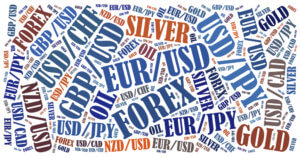The U.S. dollar index skyrocketed to 100 for the first time in almost two years on Friday. The prospect of a more aggressive pace of Federal Reserve interest rate hikes supported the currency. As a result, the dollar has gained ground on a basket of other major currencies over the past month, particularly against the euro. The latter has been under pressure due to investor concerns about the economic costs of war in Ukraine, as well as a potentially nail-biting election in France.
On Friday, the dollar index jumped as high as 100 in early European trading hours, hitting its highest level since May 2020. However, the currency lost some momentum later, trading broadly flat at 99.876 at last.
Overall, the index added 1.4% this week, showing its biggest increase in a month. Hawkish remarks from several Federal Reserve policymakers boosted the greenback. The officials are calling for a faster pace of interest rate increases to fight rapid inflation. The Fed released the minutes of its March meeting this week. It seems lots of participants were prepared to raise interest rates in 50-basis-point increments in the near future.
Meanwhile, the euro plummeted to a new one-month low of $1.0848. It exchanged hands lower by 0.2% at $1.0865. On Thursday, the European Central Bank also published meeting minutes that suggested its policymakers are keen to act to fight inflation. However, the eurozone has thus far taken a more cautious tack than other central banks, weakening the common currency.
A tightening election race in France between far-right candidate Marine Le Pen and President Emmanuel Macron has added to pressure on the euro. It also increased investor concerns about the future direction of the eurozone’s second-biggest economy. However, Macron is still ahead in the polls.
What do the analysts think?
Currency analysts at MUFG noted that the upcoming French presidential election is adding to the current negative EUR sentiment. The first round will be on Sunday.
On Friday, the greenback extended its gains against the Japanese yen. It skyrocketed to 124.23, hitting its highest in over a week and nearing last month’s almost seven-year high of 125.1. The Japanese currency has steadied this month after plunging low in March. However, it remains under pressure as the U.S. raises interest rates. The Bank of Japan intervenes in the bond market, aiming to keep rates low. The British Pound also lost ground versus the dollar. It traded lower by 0.2% at $1.30475 at last.
Indonesian shares hit a record high today in Asia, boosted by the central bank’s forecast. The latter announced that annual inflation would be within its target range, quelling some concerns around imminent interest rate hikes, as well as overnight gains on Wall Street. Consequently, equities in Indonesia gained 0.9%, eyeing their best week since early January. Furthermore, stocks in the Philippines jumped by 0.9%, marking their best day in two weeks.
The Indian rupee soared by 0.2% while its 10-year benchmark bond yield hit 7.003%, its highest level in nearly three years. Indian stocks also strengthened after the country’s central bank left its interest rates unchanged. Despite that, the bank stated that it would focus on gradually withdrawing its accommodative policy going forward as inflation increases due to the Russia-Ukraine war.
Indonesia’s central bank also noted it expects this year’s inflation to be at the upper bound of its target range or near 4% due to pressures from rallying global commodity prices. However, the bank was confident that it would remain with the target of 2%-4%.
How is the Indonesian rupiah faring?
The Indonesian rupiah traded flat on Friday. It had hit its lowest nearly one month earlier in the session but managed to recover later. The Philippine peso also tumbled down by 0.1%.
Most Asian stocks also regained some ground after extending losses earlier in the week. Analysts at OCBC noted that traders seemed to gradually digest the Fed’s hawkish stance on rate increases while the greenback hit a near two-year high and continued to drag the regional currencies lower.
According to analysts at Maybank, buoyant UST yields might weigh on foreign flows into IDR bonds in the interim. However, drags on IDR could be mitigated to some extent, especially if prices of its coal exports see support following the EU ban on imports of Russian coal.
Coal users in South Korea and Japan have also halted Russian coal import in the recent months following its invasion of Ukraine. They are now trying to find alternative sources.











